The Lluc Monastery (Monestir de Lluc) is located in the Tramuntana mountains and is a very popular destination for day trippers and hikers on Mallorca. It is 500 metres above sea level, which makes a trip to Lluc particularly interesting on a hot summer day. Both the monastery itself and the landscape around Lluc are worth seeing. The monastery also offers a cheap hostel for the many hikers and cyclists in the Tramuntana mountains.
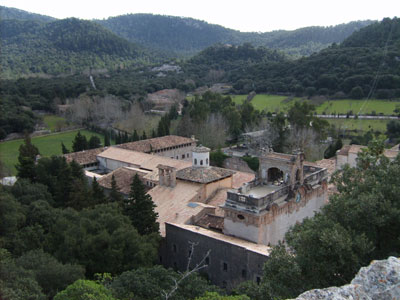
History
The monastery dates back to the 13th century and was built around a statue of the Virgin Mary, which is considered holy. Legend has it that a shepherd boy named Lluc found the statue, which was later venerated as the patron saint of Mallorca. Since then, the monastery has been a popular place of pilgrimage.
highlights
The Black Madonna (La Moreneta): The statue of the Virgin Mary venerated in the monastery’s basilica is the central shrine of the monastery, and many pilgrims visit the site to see it.
Basilica of Lluc: This beautiful church was built in the Baroque style and impresses with its sumptuous furnishings.
Botanical Garden: There is a small garden near the monastery that displays the flora of the Tramuntana mountains.
Museum of Lluc: This exhibits religious artwork, historical objects and archaeological finds from the region.
Singing of the Escolania Choir: The monastery’s children’s choir, known as Els Blauets, performs regularly and delights visitors with traditional songs.
Activities
Hiking: Lluc is an ideal base for hiking in the Serra de Tramuntana, including the popular route to Puig de Massanella, the second highest peak on the island.
Pilgrimage route: The Camí Vell de Lluc is a historic pilgrimage route that leads from Caimari to the monastery.
Peace and contemplation: Many visitors come to enjoy the peaceful atmosphere, meditate or simply experience nature.
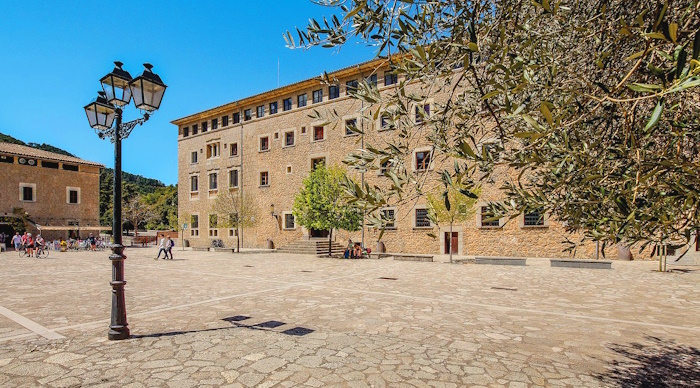
The most important building is the central monastery church with the famous statue of the Madonna “La Moreneta”. Also worth seeing are the monastery gardens and the inner courtyard of the Monestir de Lluc.
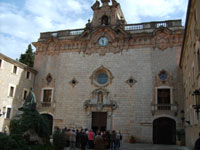
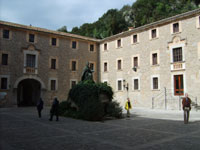
Monastery church and courtyard of Lluc
You can get a good view if you climb the hill behind the monastery (10 minutes). In several directions you can see various valleys as well as the monastery (see picture at the top). Entry to the Lluc monastery is free without the museum.
You only have to pay an entrance fee for the Lluc Museum, which is located in a wing of the main building (entrance fee around €5 in 2025). For the most part, the museum does not necessarily have much to do with the monastery itself. It is mainly concerned with Mallorca as a whole. Archaeological finds from Mallorca, pictures, textiles, ceramics, furniture and handicrafts can be seen in various rooms. It is probably only worth seeing for a museum fan or art lover. The various themes of the museum seem to have been put together arbitrarily. In addition, when we visited a few years ago, the signs were only in Catalan and Spanish and not in English and/or German.
Staying overnight at the Lluc Monastery
At the Lluc Monastery you have the option of staying overnight on site, which offers a unique experience in the midst of the tranquility of the Tramuntana mountains. Here is the most important information:
| category |
details |
| accommodation types |
single, double, family rooms and apartments |
| equipment |
Simple rooms, mostly with private bathroom; some apartments with kitchens |
| prices |
Moderate, often cheaper than hotels, especially in high season |
| special features |
Quiet atmosphere, ideal for contemplation; close to nature and hiking trails |
| choral singing |
Escolania Children’s Choir: Performance in the morning or evening for guests |
| booking |
Reservation via website or by phone recommended |
| food |
Restaurant and café with Mallorcan dishes; partial kitchen use possible |
| activities |
Hiking, meditation, visiting the monastery and the botanical garden |
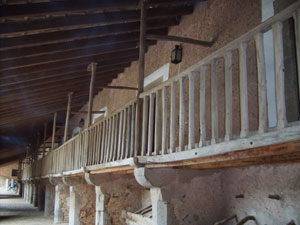
The hostel’s simple rooms are located directly in the side wing of the Lluc Monastery
At the Lluc Monastery there is a good information office for the Tramuntana mountains, the best hiking area in Mallorca. The staff at the information center are very helpful and speak good English. The information office has a very interesting exhibition about endangered animals in Mallorca, especially the rare black vultures.
Gastronomy at the Lluc Monastery
- Restaurant in the monastery
Offer: Traditional Mallorcan cuisine, simple dishes such as pa amb oli, stews and meat dishes.
Special features: Simple atmosphere, ideal for a break after a hike.
Tip: The daily menu is often inexpensive and filling.
- Cafeteria
Offer: Snacks, sandwiches, coffee and cake.
Suitable for: A quick breakfast or an afternoon snack.
- Picnic area
There are picnic areas on site where visitors can enjoy food they have brought with them in nature.
-
-
-
Buses to Lluc 2025
-
Direct bus connections to Lluc
- 1.Palma – Lluc
Line 330
Route: Palma – Inca – Lluc – Port de Pollença
Travel time: Approx. 1 hour 45 minutes from Palma.
Frequency: Several times a day, especially in high season.
Tip: Inca is a central transfer point if no direct connection is available.
- 2.Inca – Lluc
Line 330 or 332
Route: Inca – Caimari – Lluc
Travel time: Approx. 30-40 minutes.
- Frequency: Regular connections, especially in the morning and afternoon.
- 3.Port de Pollenca / Pollença – Lluc
Line 330
Route: Port de Pollença – Pollença – Lluc
Travel time: Approx. 30-40 minutes.
Map of Lluc Monastery on Mallorca
-
Lluc Hiking
The Lluc Monastery is a popular starting point for hikes in the Serra de Tramuntana, a UNESCO World Heritage Site. Here are some of the best hiking routes you can explore from Lluc:
Hike: Lluc Loop
Duration: Approx. 1.5-2 hours
Difficulty: Easy
Description: An easy loop trail that leads through the forests and rocks surrounding the monastery. Perfect for families or beginners.
Highlight: Beautiful viewpoints and the tranquility of nature.
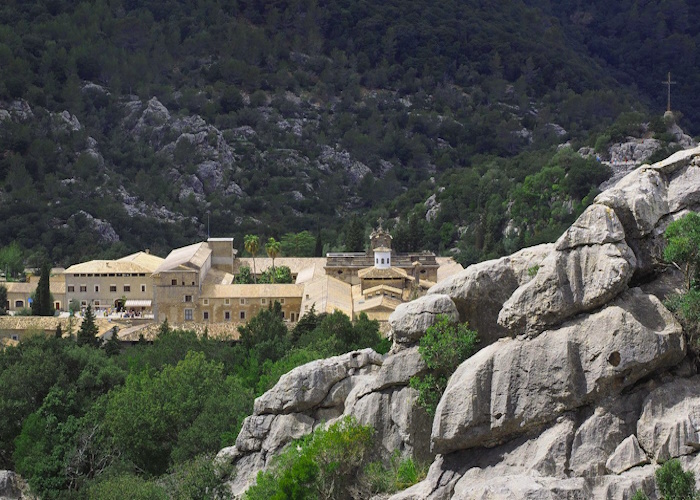
-
Hike: Puig de Massanella (1,364 m)
Duration: Approx. 4-6 hours (round trip)
Difficulty: Moderate to difficult
Description: Puig de Massanella is the second highest peak in Mallorca that can be climbed (the highest, Puig Major, is a military restricted area). The trail goes through forests, cliffs and offers breathtaking views of the island.
Highlight: A 360-degree panorama from the summit.
Tip: There is often a small fee to use the private path to the summit.
Hike: Camí Vell de Lluc (Historic Pilgrims’ Trail)
Duration: Approx. 3-4 hours (from Caimari to Lluc)
Difficulty: Moderate
Description: This historic trail was used by pilgrims to reach the monastery. The route goes through shady forests, stone paths and offers beautiful views every now and then.
Highlight: The tranquility of the path and the feeling of immersing yourself in history.
Tip: The return journey can be made by bus.
Hike: Es Barranc de Biniaraix (From Lluc to Sóller)
Duration: Approx. 6-8 hours
Difficulty: Difficult
Description: This challenging route leads through the spectacular Barranc de Biniaraix and ends in Sóller. It offers dramatic gorges, terraced fields and a real taste of the Mallorcan landscape.
Highlight: The varied landscape and the view of the Mediterranean at the end.
Tip: Plan enough time and start early.
-
Hike: Talaia d’Alcúdia
- Duration: Approx. 3 hours (round trip)
Difficulty: Medium
Description: This route starts near Lluc and takes you through forests to a viewpoint with a spectacular view of the Bay of Alcúdia.
-
The Black Madonna of Lluc
The Black Madonna of Lluc (La Moreneta) is the centerpiece of the Lluc monastery and one of the most famous religious figures in Mallorca. Here you can find everything you need to know about the statue and its meaning:
The legend of the Black Madonna
According to legend, the statue of the Virgin Mary (Verge de Lluc) was discovered in the 13th century by a shepherd boy named Lluc.
It is said to have been miraculously found in the mountains near the present-day monastery.
The statue was brought to the village several times, but always reappeared at its original location – a sign that there is a holy place there.
Appearance and meaning
Name: La Moreneta (the little dark one), because of her dark skin color.
Depiction: The Madonna holds the baby Jesus on her lap. Both wear magnificent crowns.
Meaning: She is venerated as the patron saint of Mallorca and is considered a symbol of hope, care and security.
Location and veneration
The Black Madonna is located in the basilica of the Lluc Monastery.
Visitors can see her in a gold-decorated shrine surrounded by candles and flowers.
She is particularly significant for pilgrims who visit the monastery to pray or give thanks.
Festivals and traditions
Virgin Mary’s Day (Dia de la Mare de Déu de Lluc): On September 8th, the Madonna is honored with processions and celebrations.
Pilgrimages: Many believers and hikers come to Lluc on foot to venerate the Madonna.
Interesting facts
Her dark color is probably due to the patina that has formed on the statue over the centuries, or to artistic models that depicted black Madonnas.
She is one of the most important Black Madonnas in Europe, comparable to La Moreneta in Montserrat, Catalonia.
-
Top 10 Mallorca
Basilica of Lluc
The Basilica of Lluc is the religious center of the monastery and a beautiful example of Mallorcan architecture. It was built in the 17th century in the Baroque style and attracts both believers and culture enthusiasts. Here is the most important information about the basilica:
Architecture and interior
Style: Baroque, with some elements of the Renaissance style.
Facade: The facade of the basilica is simple but elegant, with a large gate and an impressive bell tower.
Interior: The interior is richly decorated, with golden altars, elaborate wood carvings and impressive ceiling paintings.
Main altar: The altar houses the Black Madonna of Lluc (La Moreneta), which is the central religious element. The shrine is decorated with golden decorations and attracts the eyes of visitors.
Special Features
The Black Madonna: As mentioned, the statue of the Virgen de Lluc is the main shrine in the basilica and attracts thousands of pilgrims every year.
Choir of the Blauets: The monastery’s children’s choir, called Els Blauets, regularly sings in the basilica, especially during services and special ceremonies. The choir’s singing, which has a long tradition, is an unforgettable experience for visitors.
The Vault: The basilica’s ornately painted vault depicts religious scenes and is another highlight that many visitors admire.
Festivals and Ceremonies
Religious Celebrations: One of the most important religious festivals in the monastery is the festival in honor of the Black Madonna, which takes place every year on September 8th. During this festival there are processions, chants and festive masses.
Pilgrimages: Many pilgrims come to Lluc on foot from different places in Mallorca to venerate the Madonna and pray in the monastery.
Opening hours and visiting
Opening hours: The Basilica is open daily, and visitors can view it during regular worship times. For tourist visits, the Basilica is generally open throughout the day.
Admission: Visiting the Basilica is free. A fee may be charged for special tours or religious ceremonies (such as masses or concerts).
Tip for visitors
Visit early in the morning: The Basilica is often quieter in the early morning hours, and the choir singing is particularly moving.
Taking photos: As far as we know, photos are allowed inside the Basilica, but please respect the religious atmosphere, especially during masses or prayers.






